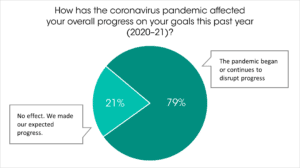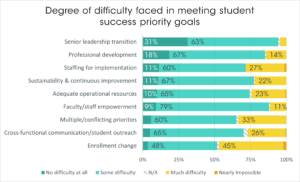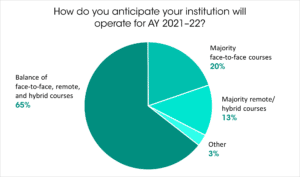Achieving the Dream’s annual reflection process is intended to help colleges in our network look at their work with different eyes as well as to help Achieving the Dream to look at ourselves through the eyes of the practitioners on our network campuses. Looking at the aggregate work of our colleges, through their own reflections, paints a rich and colorful picture of themes around institutional transformation. It also identifies opportunities for peer learning and identifies new supports our colleges need to move their work to new levels.
The following summary report is based on the 2021 reflections of ATD Network colleges and the qualitative analysis of those responses. The summary examines those responses and data through the lens of how various issues affect the transformation of institutions to be more equitable and effective in serving students (from helping them stay afloat during the pandemic to redesigning their college experience from access through completion and beyond) and to be an effective partner and anchor institution for community economic growth and renewal.
Operating in the Context of COVID-19
While the experiences of ATD Network colleges are always diverse, it appears to be more so this year given the variations in how the pandemic affected communities nationwide. Some communities experienced monumental shifts in local employment (both losses and gains), some described deep trauma and loss in their communities, and others faced natural disasters along with the pandemic. This has created both challenges and opportunities, forcing ATD Network colleges to draw on their capacity-building work and resilience to maintain their focus on serving students well in a rapidly changing environment. As one college reminds us, they are now serving students in “a radically changed social and educational environment due to the impacts of COVID-19.”
Many colleges were able to use the pandemic as a reason to push forward with needed improvements.
“COVID-19 refocused the college on the essentials of the student experience, forcing us to look with fresh eyes upon our enrollment procedures, our student-facing business practices, advising and student supports, and instructional pedagogies.”
“Yes, due to COVID-19, [our college] was able to see more clearly the inequities our students were facing, especially related to technology. While there have been attempts at removing barriers for students in the past, there has never been a name placed to it. Now [our college] has defined what equity means and can focus on removing those barriers and inequities.”
At the same time, many faced capacity issues given the magnitude of changes required. Some colleges, mindful of the capacity of staff and students, limited their focus or shifted their timelines for planned work. For some, enrollment declines caused a shift away from student success work.
Although courses have continued to be delivered, and much work has continued to progress, the additional effort required to maintain and complete work in remote conditions has been taxing for employees and students the past academic year. As a result, the areas of focus for our student success work were narrowed for AY 20/21 compared to what we had envisioned before the pandemic.
“In March of 2020 there was a halt to many initiatives that the college was involved in. Prior to COVID-19 [the college] did not offer online classes. Transitioning to online/hybrid courses while still trying to provide major supports for students and faculty and staff became the primary focus of the college.”
However, as noted in the enrollment section below, some colleges framed their student success work as an effective enrollment strategy.
While we will be navigating the impacts of the coronavirus pandemic on our students, institutions, and communities for the coming year and the long term, this year’s reflections demonstrate that the current context presents opportunities to sharpen our student success work and further transform our institutions into hubs of equitable change for more students and be drivers of social and economic stability for our communities.
Working Toward Student Success: Key Areas of Focus
Responding to enrollment challenges
Fall 2021 enrollments numbers show a 14-percent drop in community college enrollments since Fall 2019. This is part of what the National Student Clearinghouse says is the largest two-year enrollment decline in the last 50 years. It comes as no surprise, then, that the vast majority of ATD Network institutions (85 percent) identified enrollment as the most challenging issue in meeting student success goals this year. Forty-five percent of institutions noted that enrollment changes caused “much difficulty” while 2 percent described these challenges as “nearly impossible.” Except for having to face multiple conflicting responsibilities, which a third of colleges said posed much difficulty, the enrollment problem was about twice as challenging as most other areas.
To address enrollment challenges, in general institutions reported placing more emphasis on outreach, including transitioning outreach efforts online. Other approaches included:
- Focusing on particular student populations and communities. Institutions set enrollment targets regarding specific student populations as part of their diversity, equity, and inclusion (DEI) work to increase diversity of students served or better represent the communities they serve.
- Connecting with student and community needs. More institutions are focusing on improving the overall student experience at the institution and within the community. College and community contexts had a strong effect on addressing enrollment issues. A handful of the institutions saw improved enrollments, and, in a few places, the pandemic created an opportunity to bring more students into the college and meet community needs at the same time.
“With the declines in enrollment due to COVID-19, we are working to better understand student needs and how to best manage enrollment from connection to entry and through the institution.”
“When the pandemic hit in March 2020, the unemployment rate of [our] area jumped from 3.88% to 17.36%. In response, [the college] used state relief funds to quickly develop the GEER project, which fast-tracked enrollment for minority, first-generation and/or students living in poverty. [The college] provided guidance, tuition assistance, forgiveness of overdue tuition bills, technology, and internet service, as well as job placement assistance post completion. Community based partners provided additional support through case management, mentoring, and safe spaces for studying and technology assistance. The program enrolled over 130 students.”
- Leveraging K–12 partnerships. Institutions increased dual enrollment opportunities and partnerships with their K–12 school districts by embedding advisers in high schools, increasing dual credit offerings, and supporting dual credit students with hotspots for internet access.
- Making better use of disaggregated data. Colleges examined data to better understand their enrollment changes, identifying who is not enrolling and how student populations are changing.
These reflections will continue to inform ATD’s work to develop more equity-centered and community-based approaches to access and enrollment. It is time to move away from the assumption that students will naturally come to us and toward a mindset that sees our role as reaching deep into our communities to serve more disconnected learners. Rather than focus on standard marketing and recruitment approaches to maximize yield, community colleges must meet students where they are with early, extensive, and continuing engagement. This includes connecting students with holistic supports from the outset and offering a portfolio of programs that match the life cycle of the education and training needs of students, workers, and employers.
ADDRESSING WORKFORCE NEEDS
This year almost every institution mentioned that they are paying increased attention to workforce development issues as we continue to recover from the pandemic and the economic fallout. Specific areas of focus include accelerating efforts to help furloughed or laid-off workers in decimated industries re-enter the job market. Some institutions, for example, noted that they are offering more short-term certificates, rapid credentialing programs, and competency-based education programs to help students who have stopped out gain traction in growth fields like manufacturing, information technology, allied health, and nursing.
“As the economy rebounds the college remains focused on meeting the business needs of the community. As individuals who were furloughed or laid off re-enter the job market, there has been an increasing need for short-term certificates and quick entry into the labor market. The college’s Rapid Credentialing Programs respond directly to that need by offering programs in a variety of fields, such as manufacturing, information technology, and health care that prepare students to enter high-demand, high-wage careers in a year or less.”
“As a result of the pandemic, there are many displaced workers looking for new jobs and careers. The college has committed to helping these displaced individuals transition to employment by identifying the necessary short-term (six months or less) training programs that help displaced workers acquire the skills needed for r-employment. The college continues its development of Accelerate My Degree, a competency-based education (CBE) model that supports students who have stopped out and have gained workplace experience that can contribute toward degree completion.”
Colleges identified a range of strategies and approaches to addressing workforce needs, including:
- Strengthening partnerships with employers. Colleges indicated renewed efforts to partner with employers to identify their needs and match students with employment opportunities that require additional or different education and training. In some cases, colleges noted that labor demands resulted in a strong opportunity to not only increase enrollment but to reach first-generation students.
- Making better use of employment data. Institutions are also accessing employment data from their communities and states to guide their program offerings. One college shared, “All of our [career and technical education] areas are in connection with state and local organizations that provide data and outlook … our managers and faculty are doing what they can to stay abreast and to engage potential students in what we have to offer.”
- Leveraging short-term credentials. Institutions are re-examining how to effectively implement stackable short-term credentials that enable students to upskill or reskill for re-entry into the workforce as well as setting them up for additional education and training in the future.
- Developing support for adult students. Colleges also reported that finding ways to help adult students seeking to reskill, upskill, or enter college for the first time was an important effort to meeting workforce needs but also acknowledged that some adults struggled to attend, especially if they had additional caretaking responsibilities as the pandemic shut down schools and services.
The reflections demonstrate the need for colleges to continue strengthening their position as community hubs and working to ensure their programming serves students and local employers. We know this will be important work going forward given our rapidly changing economy. Just as one example, according a recent McKinsey report, 17 million workers may need to transition to new jobs post-pandemic. ATD is already including more of this focus into our work, reimagining access as an extended engagement with students over the life of their careers, making better use of data to examine program enrollments and completions with an equity lens focused on labor market outcomes, and supporting colleges as they develop programming to prepare students for work in the digital economy. This will be an area in which significant engagement with Network colleges will be critical to ATD’s future work.
CONTINUING TO CENTER EQUITY
As we work to center equity in all our student success work, it is encouraging to see that every institution cited equity in their reflections and many noted that this is a historic moment to push the work forward.
“The college has been thinking about equity and higher education for some time given the nature of the student population’s significant numbers of Hispanic, Pell-eligible, first-generation students. COVID and the killing of George Floyd prompted a group of faculty to organize a working group that also included the president and vice presidents of the college. The group set out two goals: (1) increase awareness among faculty and staff about how inequities manifest in higher education, and (2) develop a framework for using data to assess equity gaps.”
Equity work across the Network ranges from colleges who are just beginning that work by identifying their opportunity gaps or writing equity statements to those who are deeper into the work and are taking a hard look at structures and policies. Strategies for working on equity issues included:
- Strengthening professional development. Colleges reported that professional development around equity included broad work understanding DEI concepts, lecture series focused on topics of racism, work on developing culturally relevant pedagogies, and disaggregating classroom-level data to identify need changes and opportunity gaps. Some colleges expanded that professional development into seminar series that included students. Many institutions are empowering their teaching and learning centers to take the lead on professional development.
“Our Center for Teaching and Learning provides professional development strategies for faculty so that they can design curriculum and deliver instruction that incorporate the theories and practices of active learning.”
- Eliminating equity gaps. More colleges have added specific goals around reducing or eliminating equity gaps than in prior years. Some colleges reported getting more sophisticated in that work looking at equity gaps not just overall but by program of study, employment outcomes, or incorporating intersectionality to their models.
- Diversifying faculty and staff. Several colleges are focusing specifically on hiring pipelines to increase the diversity of their faculty and staff to better represent their student body.
- Establishing senior leadership on equity. More colleges are dedicating a position to lead DEI work and elevating that position to the president’s cabinet.
The breadth and depth of equity work across the Network demonstrate that there is a strong foundation to move this important work forward although as many colleges indicated there is still significant work to be done. In fact, building a culture of equity was the top area identified by colleges where ATD’s assistance was needed. Those reflections will inform our efforts to continue to build our equity services to support Network colleges in this area, but just as importantly to see all of our work with institutions through an equity lens as creating anti-racist institutions requires whole-college transformation.
IMPACT OF THE SHIFT TO VIRTUAL EDUCATION
Colleges also discussed efforts to continue supporting student success work in the virtual environment both in terms of supporting effective teaching and learning and providing student support services in a virtual environment.
Teaching and Learning
For most of our colleges, the bulk of their courses were still delivered in virtual formats over the course of the past year, although generally colleges reported this year was more about remaining flexible and improving quality rather than the crisis mode of the fast pivots required during the initial phase of the pandemic. Colleges primarily sought to improve teaching and learning through continued professional development in teaching online and supporting culturally relevant pedagogies. They also invested in additional infrastructure for online courses, including learning management systems, student information systems, early alert software, and systems to improve communications with students.
At the time of the reflection, colleges expected to be serving students in multiple modalities, including hybrid flexible (HyFlex) courses.
Virtual Student Support Services
Respondents discussed at great length steps to meet students’ basic needs as a result of the pandemic and the continued work to move advising to virtual formats as their institutions shifted to online learning. This shift was successful for the majority of colleges and something that many colleges are planning to continue even when campuses are fully open. Virtual advising helped colleges provide services beyond the workday, and often increased attendance since students did not need to travel to campus to access their counselors.
“Dependence on virtual communication has awakened a new element of creativity for reaching out to students, from recruitment to counseling to student activities. The virtual solutions developed during the pandemic have, in many cases, democratized and even expanded participation. There will be many of these necessity-driven communication and support solutions that will be carried over into the new normal.”
For some colleges virtual services went beyond advising. Colleges created virtual one-stop centers to provide easy access for students. Colleges invested in chatbots and infrastructure to allow students to make appointments easily and make virtual student services more sustainable for the future.
“The lasting lesson for the college is that this virtual interaction, engagement and connection needs to continue as a valuable option even as more teaching and service provision goes back to face to face. Allowing students to continue using virtual options will significantly impact student success, retention and completion.”
Final Thoughts
Working with capacity constraints and new demands, ATD Network institutions continued to adapt and innovate in one of the most challenging years in memory. By and large, they continued to make progress in transforming their operations by providing new ways of supporting students and their learning, responding to the economic and workforce needs of communities, and moving equity from guiding principle into action, taking strategic steps to eliminate structures and policies that limit student success.
The issues that surfaced in these reflections will likely come as little surprise to ATD Network leaders who have experienced so many challenges over the last two years. By sharing this information, we hope that colleges in the Network will get a glimpse of what institutional transformation looks like even in the most challenging circumstances and that leaders can use this to gauge their own progress and challenges within a broader perspective.
We believe that the ability of our institutions to press on with the hard work of organizational improvement during the pandemic and the new recession, to rethink enrollment and access, to put equity at the center of our work and find new ways to leverage our localness, are essential steps to secure the future of our institutions and our sector.
We hope that these reflections provide an opportunity for Network colleges to take note of the experiences of others and be inspired by and continue to learn from each other. We will use the extensive data and observations we have gathered to inform all aspects of Achieving the Dream’s work. We will use the information you have shared to continue to align our priorities, programming, services, and coaching to meet the ongoing and emerging needs of our Network colleges.


